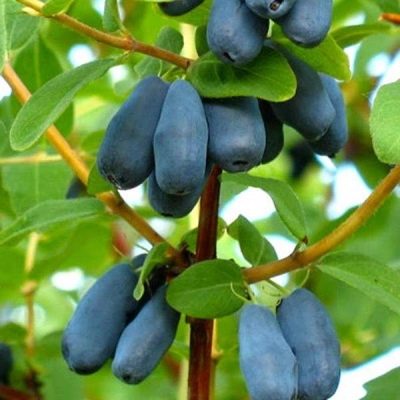
- Authors: Plekhanova Maria Nikolaevna, Kondrikova Alexandra Vasilievna
- Year of approval: 1999
- Growth type: vigorous
- Description of the bush: medium spreading
- Bush height, m: 1,5
- Escapes: thick, straight, light green, hairless
- Leaves: large, dark green, elongated-oval, with a pointed tip and base
- Transportability: fruits are transportable
- Crown: thin, rounded
- Fruit size: large
Swan is a typical representative of the domestic selection of the Kamchatka honeysuckle line with characteristics typical of this variety. He has large fruits, good yield indicators, a beautiful small bush that can become a real decoration of the garden.
Description of the variety
A vigorous shrub, reaching a height of 1.5-2 m. The plant is moderately spreading with a loose and rounded shape. For the first few years, the crop shows a slower growth rate, which accelerates with the onset of fruiting. Shoots are thick and straight, light green in color. The leaves are rather large, dark green in color, pointed at the apex and base. Blooms in small inflorescences in early May.
Fruit characteristics
The berries are large. On average, the weight of one fruit is 1.2-1.6 g, with a thick, bumpy skin and a weakly pronounced bluish waxy bloom. Their shape is elongated-oval with a strongly elongated curved base. The color is bluish blue. The stalk is fixed very tightly on the fruits, so the separation is difficult. When ripe, the berries do not crumble, retain their taste and marketability for a long time, calmly tolerate transportation.
Taste qualities
The taste is sweet and refreshing, with a mild berry aroma. The tasting score is high - 4.8 points out of 5 due to the sourness present in the taste, which is due to the presence of a large amount of ascorbic acid. The consistency of the pulp is dense and gristly. Honeysuckle is widely used in cooking. Delicious and aromatic fillings for desserts, mousses, juices are obtained. It is useful to eat fresh berries.
Ripening and fruiting
The variety is mid-season, fruit ripening begins in June. However, the timing depends on the characteristics of the growing region, the warmer, the earlier. The culture enters fruiting in the 4th year of planting, while giving stable yields annually. The collection time is extended and can be about 30 days.
Yield
The yield indicators of the variety are average, but stable. An average of 2.5 kg of berries or 40 kg / ha are harvested from one bush.

Growing regions
It can be cultivated in all regions of Russia. However, some peculiarities should be taken into account. At the heart of the Swan are Kamchatka varieties, therefore, it is characterized by high frost resistance, withstands temperatures up to -50 degrees without shelter. But drought resistance is average. The lack of moisture in the soil and air affects the size and taste of the fruits, they become smaller and bitterness appears.
Self-fertility and the need for pollinators
The variety does not pollinate on its own. It is necessary to plant additional plants for pollination. For this, honeysuckle varieties such as Blue Spindle, Kamchadalka, Malvina, Morena, Memory of Kuminov and Blue Bird are better suited.
Growing and care
The best time for planting is autumn. The shrub is planted 1.5-2 months before the onset of frost. During this time, the plant will have time to take root and overwinter without loss. In the spring, planting is not carried out, sap flow will begin, and it will be difficult for the culture to adapt.Because of this, the bush will be very painful and significantly lag behind in development.
The Swan grows better in sunny places, but is able to put up with a little partial shade. The variety is afraid of drafts, requires mandatory protection. Prefers to grow on fertile, well-drained soils. The culture does not take root on sandy soils.
Planting material can be purchased at the nursery or root cuttings yourself. The seedlings should have a well-developed root system with 3 strong shoots. Particular attention should be paid to the bark. It should be free of mechanical damage and any signs of disease.
The landing pit is prepared in advance. The volume depends on the root system. A drainage layer of crushed stone or broken brick is laid at the bottom. A nutrient mixture is prepared, consisting of garden soil, compost, wood ash and superphosphate.
Seedlings with open roots should be soaked for several hours in a root-forming solution. Since the bush grows strongly, the planting interval between plants should be at least 1.8 m. The bush is set in the center and covered with soil. The root collar should be on the surface. Shoots are cut, leaving 4-6 buds.
For the first few years, the Swan will have enough food that was introduced during planting. Top dressing begins to be applied from 3 years of growth. In the spring, the culture needs organic matter, in the fall - potassium and phosphorus.
Water the honeysuckle once a week. Do not allow waterlogging. Irrigation is increased when dry weather sets in. For less moisture loss, a layer of mulch is laid from the soil.
A prerequisite for proper agricultural technology is pruning, which is carried out only in the fall. Spring rejuvenation is carried out 2 weeks after the fruit buds swell.



































































